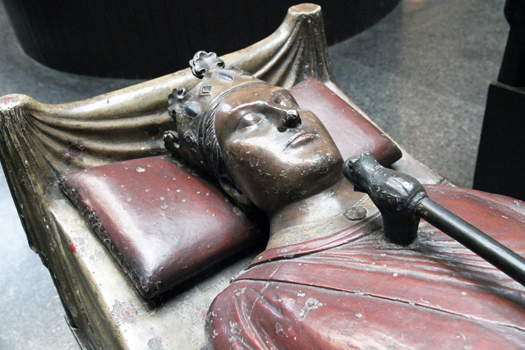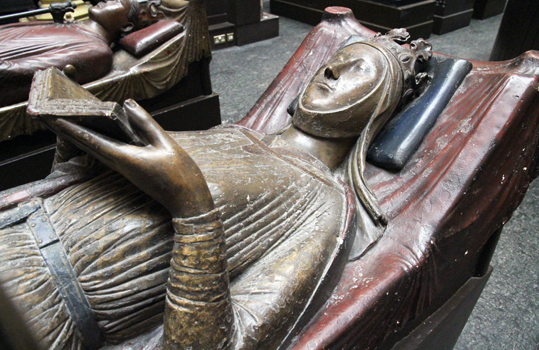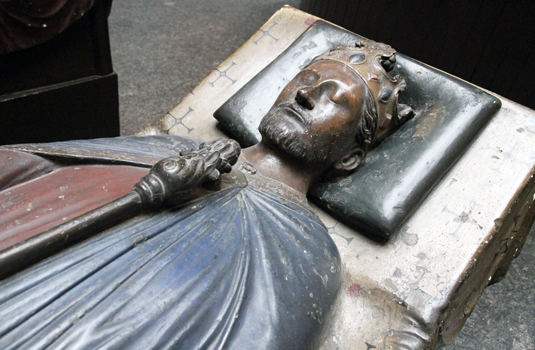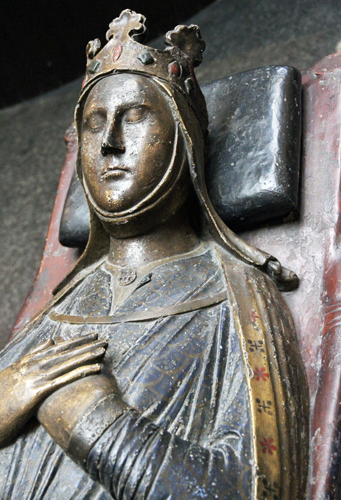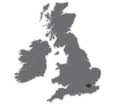 |
 |
GREATER LONDON |
 |
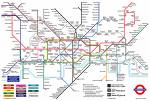 |
| <City of London I > <City of London II> <City of London III> <City of Westminster-1> <City of Westminster-2> <City of Westminster-3> <City of Westminster-4> <Borough of Wandsworth> Casting the Tombs England France Germany Italy Spain Note that the countries are the countries of today, not those the commemorated may have recognized |
 |
BOROUGH OF KENSINGTON & CHELSEA |
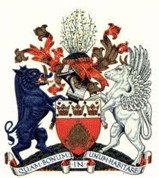 |
| Victoria & Albert Museum |
|
V & A Museum, Cromwell Road, Knightsbridge, London SW 2RL Entry is free but certain exhibitions may be charged for. Opening hours: Daily, 10.00 am until 5.45 pm except Friday, 10.00 am until 10.00 pm. But check the web site. |
| As well as a series of original effiges, obtained from several churches, in the Museum, there are many monumental effigies which are either plaster casts or electrotypes of the originals. These latter date from the mid to late nineteenth century and were made by leading cast makers of the day; they were bought by the museum to enable visitors to see these effigies without the then difficulty or high cost of travelling to see them. To some extend this still applies today and we must also now add the new additional problem of the ease or even possibility of access to the building housing them. Although it was never intended to do so these casts now allow visitors to see some of the effigies which are in Westminster Abbey without the high cost and restrictions of doing so. |
| Casting the Tombs |
|
Plaster Casts The initial impression of the original was often taken in plaster. The original was coated with a thin layer of a separating material to prevent the plaster sticking to the original. Because plaster is rigid when set and because most effigies - other than those in very low relief - have projections and undercut areas, these impressions were taken in sections; otherwise it would be impossible to remove the impresson without it fracturing and probably causing damage to the original work. The sections are called piece-moulds and are held together by a mother-mould, so that the sections can be reassembeled.These sections were then reassembled in an outer case and again painted with a separating material or mould seal, and the liquid plaster poured in. The plaster impressions were then removed leaving an accurate reproduction - other than the fine lines where the sections join- of the original effigy. The plaster impressions could be reused to produced a further cast. Impressions were also taken a mixture of wax and gutta-percha or gelatin, which are slightly flexible, as well as clay. As someone who has used this technique on a small scale, I can only but greatly admire the amazing skill of these cast makers. New rubber base materials which are highly flexible as well as very accurate would certainly make this process much easier today as well.
|
|
Electrotypes
This process produces a metal copy of the original. Again an impression of the
original is taken but now the impression is coated on the
inside with a graphite to give a thin, electrically
conductive layer. To add a layer of metallic copper to the
inside of the impression, it is inserted into an aqueous
electrolyte solution of copper sulphate and sulphuric acid,
and then connected to a direct electric current source as
the cathode, the anode being metallic
copper. When the current is activated, the copper anode
begins to desolve in the electrolyte and
deposited on the inside of the impression. When this copper
reaches the required depth the current is turned off, the
impression removed from the elctrolyte and, when the
impression is removed from the copper 'lining' a copper copy
of the original is produced.
This process is rather similar to that used during the production of vinyl and shellac sound recordings |
| For a history of the V&A's cast collection - of all types of sculpture - click here. |
| England |
| Westminster Abbey, City of
Westminster, London A Collegiate Church and a Peculiar. The most expensive church to visit in the world. |
 King Henry III |
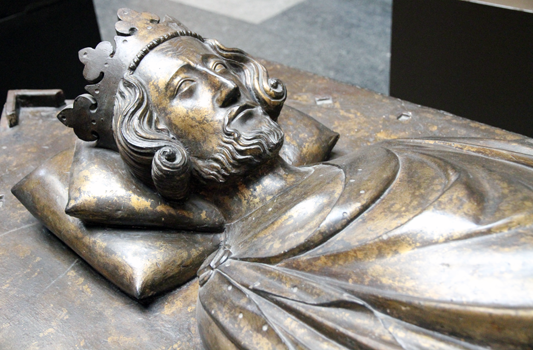
|
|
 Queen Eleanor of Castile |
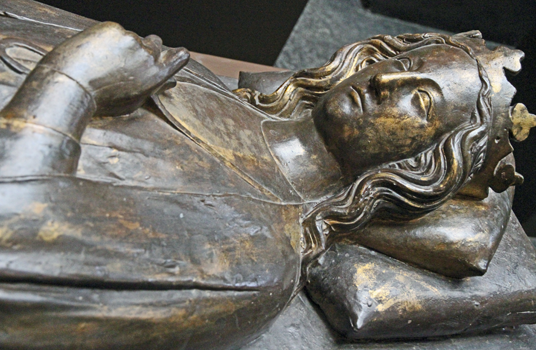 |
|
|
| The Temple Church, London A 'Peculiar' church. It belongs to two of the four Inns of Court: it is thus the Barristers' own chapel. It is thus not a parish church and the minister is titled 'Master of the Temple' Do not let this deter you: it is open to visitors. |
 William Marshall (1219) (RCHM no 10)  Unknown (RCHM no 7)  Gilbert Marshal (1241) (RCHM no 9) |
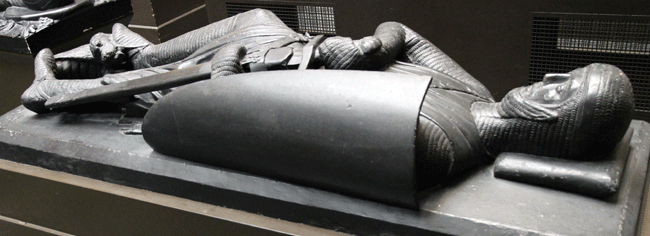 William Marshall II (1231) (RCHM no 8) |
 |
|
| Notes | |
|
| Formerly in Lesnes Abbey, Kent (The London Bourough
of Bexley) Lesnes Abbey is a ruined abbey and open to the public. |
 |
 |
| An unknown knight of the Lucy family (1340-50) | |
| This effigy was discovered during excavations at the abbey and is now housed in the V&A. It is thought to represent a member of the Lucy family. The effigy is of Totterhome limestone with gesso, painted and gilded: this can be seen in the photograph on the left which was mainly in daylight. Medieval and Renaissance Room | |
| Worcester Cathedral A Cathedral Church. Open to visitors |
 |
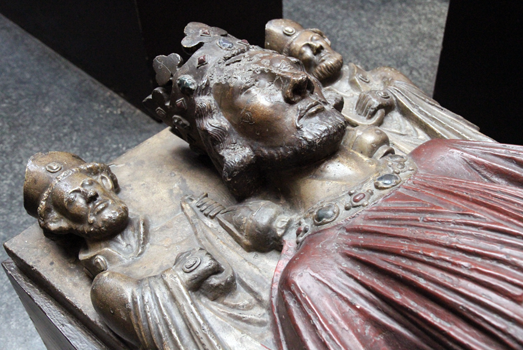 |
|
|
| Church of St John the Baptist, Lewes, Sussex A parish church |
Salisbury Cathedral, Salisbury,
Wiltshire Open to the public |
 |
 |
| 1. Gundrada is said to
have been a daughter of William the Conqueror. 2. She and her husband, William de Warenne, 1st Earl of Surrey, founded Lewes Priory but their remains and monuments were lost over the years. 3. Gundrada's tomb slab was found in Isfield Church covering a 16th century burial. It is of Tournai marble and dates from the later 12th century 4. Two lead chests containing the remains of Gundrada and William were found when the priory was excavated. The remains were sealed into new chests but the original ones are, together with the tomb slab, to be seen in the church indicated above 5. Plaster Cast. Room 46A |
1. This
is a 12th century coffin lid
of
Tournai marble integral with the flat effigy of a
bishop. 2. The head is in higher relief but this is a 14th century replcement and of Purbeck marble. 3. The slab came from Old Sarum, near Salisbury, where Roger was buried and late brought to the new cathedral at Salisbury to where the see was transferred. 4. Roger was a very wordly bishop and held the important secular posts of Lord Chancellor and Chief Justicicar 5. Plaster Cast. Room 46A |
| York Minster A cathedral church open to visitors |
|
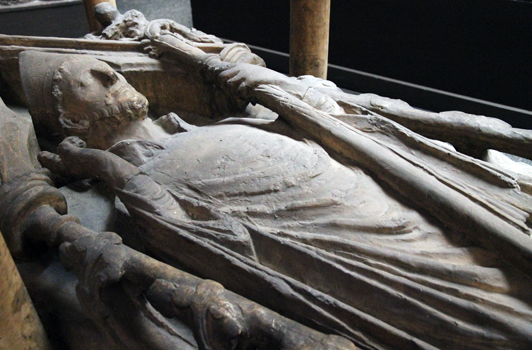 |
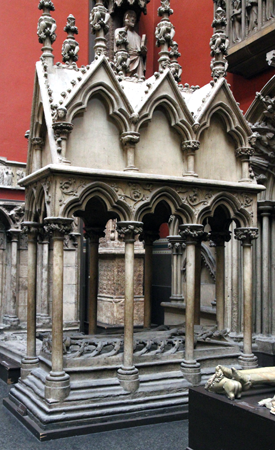 |
| 1. The monument is of Purbeck marble. 2. He is robed as a bishop rather than an archbishop 3. Under the effigy is a coffin with a painted effigy on the lid. 4. He was Lord Chancellor under King John 5. He was appointed Archbishop of York under the influence of King John and the Pope but the canons of York rejected his, feeling he was too poorly educated, and elected the brother of the Archbishop of Canterbury (an enemy of the King) instead. Walter eventually paid over £10,000 in papal fees to have his appontment confirmed. 6. Plaster Cast. Room 46A |
|
| Church of St Mary and St
Barlock, Norbury, Derbyshire A Parish Church |
||
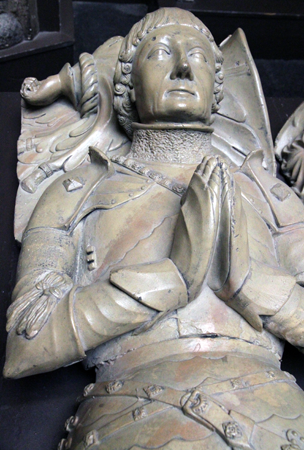 |
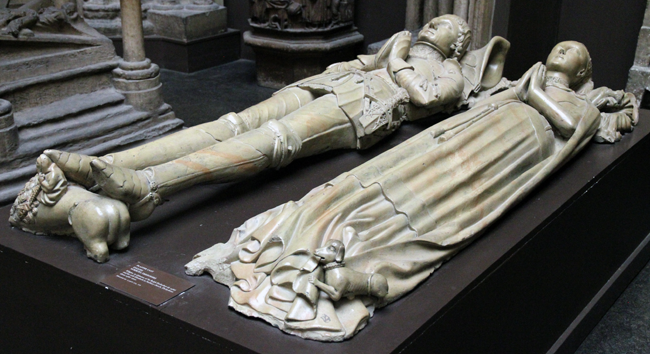 |
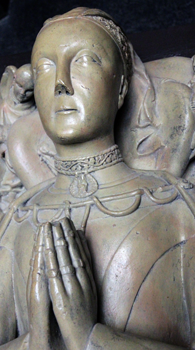 |
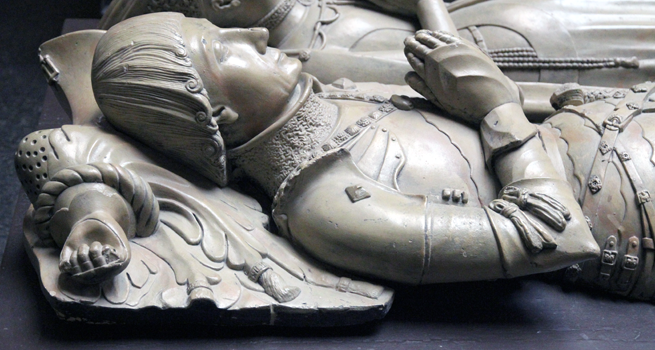 |
 |
| Sir Ralph Fitzherbert (1483) and his wife Elizabeth | |
| 1. The original monument is
of alabaster. There are other monuments of interest in the
church 2. Plaster Cast. Room 46A |
|
| Chichester Cathedral,
Sussex A Cathedral Church, open to visitors |
|
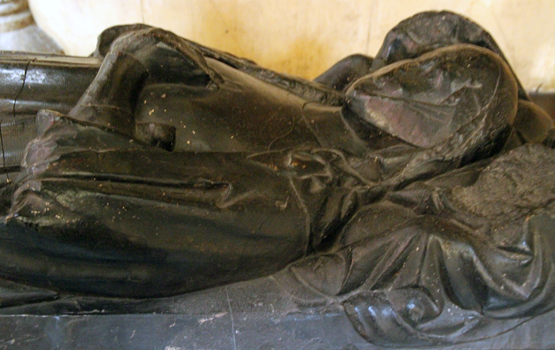 Joan de Vere c. 1300 (uncertain) |
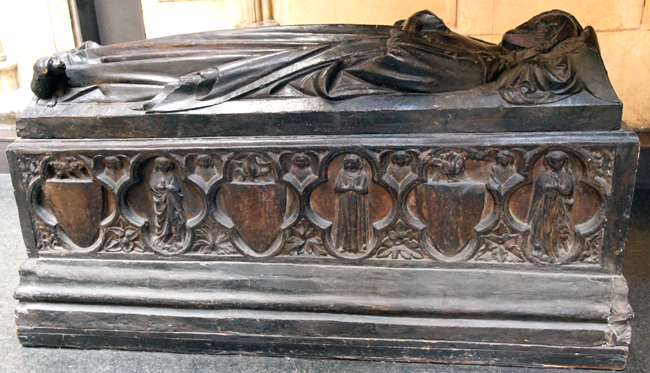 |
| 1. The monument is of Caen
Stone. 2. The monument was moved from Lewes Priory at the Dissolution to Chichester Cathedral 3. Plaster Cast. Room 46A |
|
| Essex | St Denis's
Church, Faxton Nr Lamport, Northamtonshire |
|||
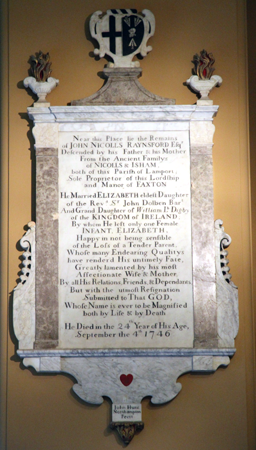 |
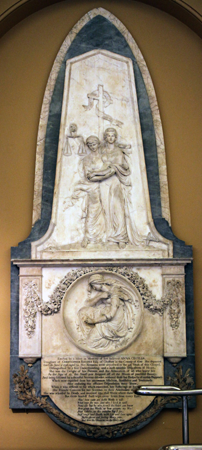 |
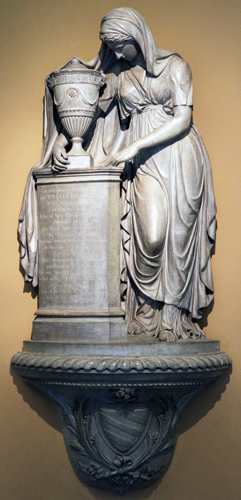 |
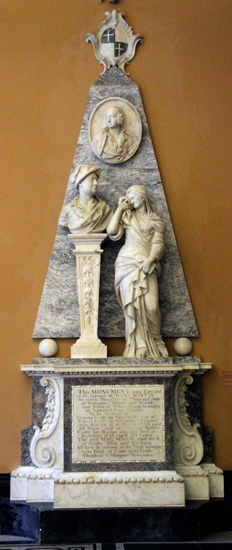 |
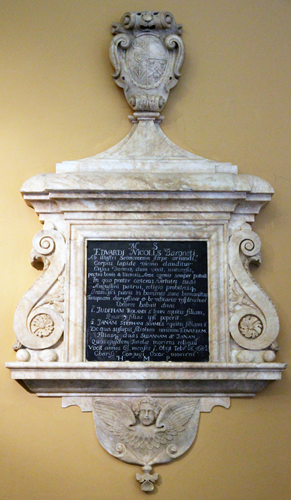 |
| John Nicholls Raynsford (1746) | Anna Cecilia Rhodes (1794) | Sir William Hillman Kn (1793) | Thomas (1732) & Robert (1741) Crosse | Sir Edward Nicholls Bt (1682) and his wives: Judith and Jane |
| Further information above from left to right: 1. White marble and gilded and painted wood. Signed: John Hunt Northampton fecit. Sculpture Room 24. 2. By John Bacon the Younger. From the demolished Church of St James, Hampstead, London 3. 'Of His Majesty's Board of Green Cloth' 4. Given by the Incumbent, Parochial Church Council and Church Wardens of of St Stephen's, Ty Green and St Andrew's, Nettleswell, Essex. Erected by Mary Martin in memory of her nephew Thomas and her brother Robert (1741) 5. The monument was made of gypsum alabaster in Northamptonshire c. 1682. The central panel carrying the Latin inscription is of black marble, which states that his body is 'covered by a tombstone nearby. The church was made redundant in 1939 and demolished in 1958. No one now lives in the village. Several monuments were moved to the stables of Lamport rectory but not all have come to the museum; the above was given in 1965. Sir Edward was a Paliamentarian and married twice: 1. to Judith (Roland) by who he had seven daughters, 2. to Jane (Stephen Soames) by who he had 1 son and 2 daughters. Room 24 | ||||
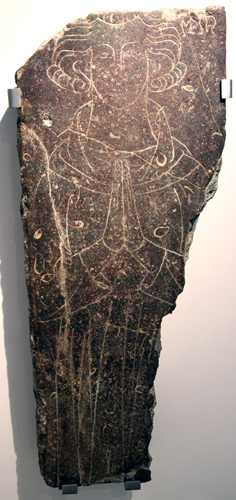 |
Sawley, Derbyshire |
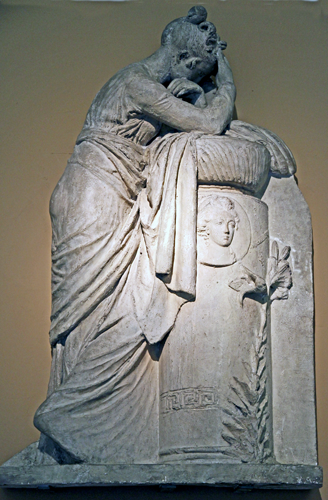 |
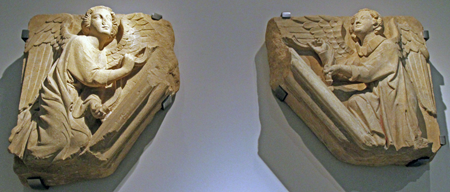 |
||
| Above:Two fragments of a tomb canopy showing
angels with censers, probably made in Lincoln 1270-80 and of
dolomite limestone. The are from a tomb which was dismantled in
1980, the effigy of which, a cleric, still remains in the
church. Some of the fragment were lent to the V&A by the Rector,
Parochial Chuch Council and Church Wardens of the parish of
Sawley, Derbyshie. Room 10. Left: Fragment of incised slab. No further information. Right: Premliminary plaster study for the monument of Hon. Barbara Lowther which is in the Church of St Mary Magdelene, Richmond, Surrey. By John Flaxman c. 1805. There is a similar earlier study in the Museum with the portrait medallion. On loan from University College. |
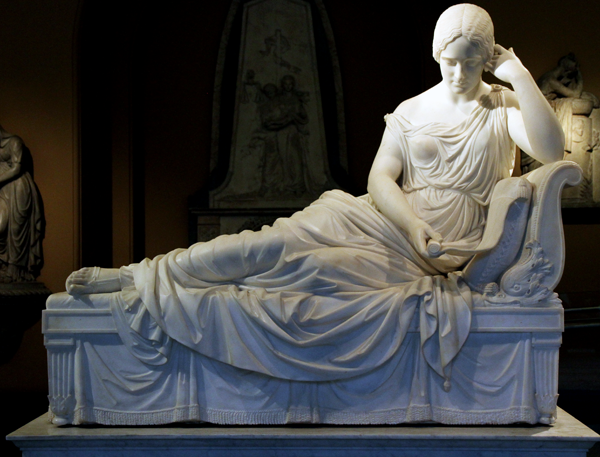 |
 |
 |
| Emily Georgiana (1849) Wife of George William, Earl of Winchelsea and Nottingham Buried at Ewerby Church, Lincolnshire |
Sir John Tyrell Bart (1766
at 40) Dame Mary (1766 at 31) |
| St Mary's Church, Eastwell, Kent |
| The monuments of the Finch family below were given by the Rector and Churchwards of the Parish of Eastwell and Broughton Aluph, the church of Eastwell having fallen into decay before finally collapsing in the 1960's |
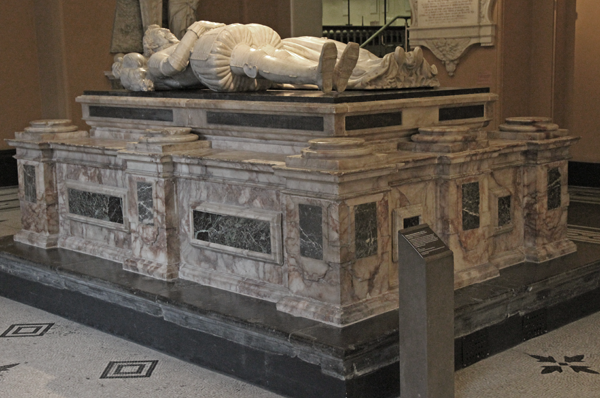 |
 |
 |
|
Sir Moyle Finch Bt (1614) and Lady Elizabeth Finch (1634) |
|
| The
monument to Sir Moyle Finch and Lady Elizabeth Finch (later
Viscountess of Maidstone in 1623 and later Countess of Maidstone
in 1623) was constructed c. 1630 by Nicholas Stone the Elder.
The tomb chest is of alabaster, the surrounding pavement of white
marble and the effigies of white Carrara marble. It was
constructed after the death of Sir Moyle but during the lifetime
of Lady Elizabeth; note that the effigy of the former is
portrayed with the eyes closed but the latter with the eyes
open. The monument originally had a canopy supported by eight
marble columns but this was removed in 1756 as it was believed
to be in danger of collapse; the bases of these columns still
remain and may be seen. above. The names of their children
are inscribed around the base. |
|
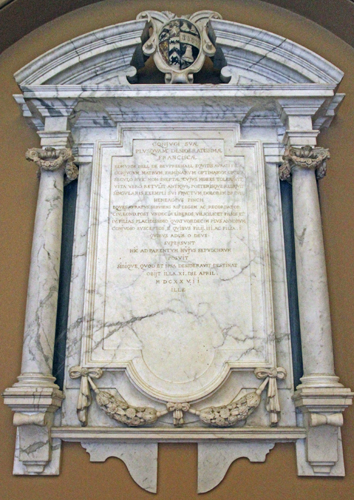 Frances Lady Finch (Bell) (1627) |
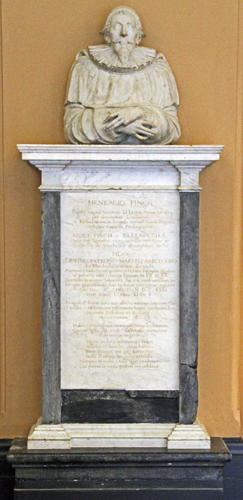
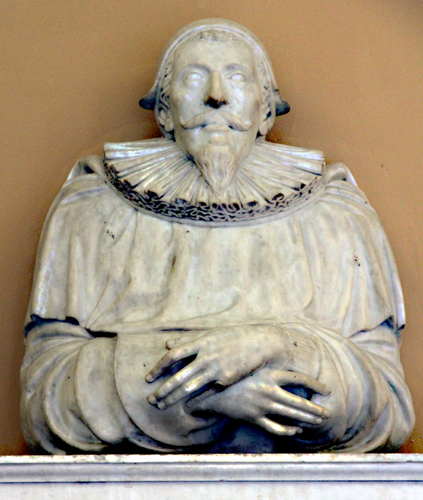 Sir Heneage Finch (1631) |
| Marble made in England c. 1627 by Nicholas Stone the Elder. Frances was the first wife of Sir Heneage Finch and by him had seven sons and four daughters in their fourteen years of marriage, of whom three of the former and one of the latter survived infancy. The monument was intended for both Lady Frances and Sir Heneage, the Latin inscription being left blank so that his date of death could be inserted later: 'He himself...' However Sir Heneage remarried in 1629 and is commenorated by a separate monument. Room 24 | This monument to Sir Heneage Finch alluded to on the left, one time Speaker of the House of Commons, is also of marble and was made in 1632 again by Nicholas Stone. Room 24. |
| St Mary's Church, Horney, Middlesex | |
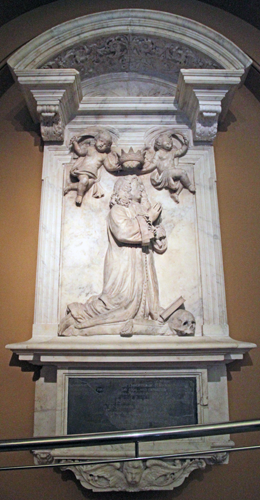 |
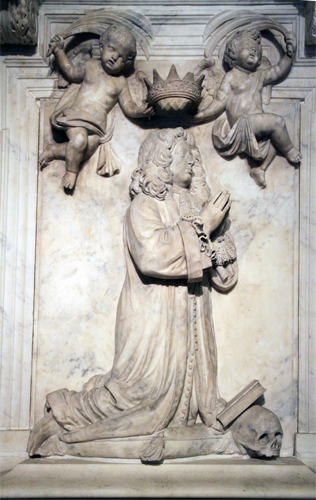 |
| Francis Musters (1680) Died at 15 |
|
| Marble by Caius Gabriel Cibber (Danish) made in 1680. The monument was in the church of St Mary, which was demolished and replaced by a modern church. For reasons I cannot discover the monument was not moved to the new church; it was purchased by the Museum from Finch & Co. Room 24. | |
| Church of St Alkmund, Whitchurch, Shropshire |
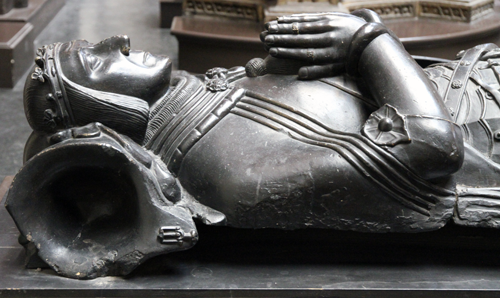 |
 |
 |
 |
| John Talbot, Earl of Shrewsbury |
| This is a plaster cast of the original effigy of John Talbot, Earl of Shrewsbury, made in London sometime after 1850 and given to the Museum by the Architectural Association. The original of stone was carved 1453 - 1500 and may be seen in Whitchurch Church. John Talbot was successful military commander in the latter stages Hundred Year's War under the far from military King Henry VI ; a hero of his time he was killed in the Battle of Castillon on 17th July 1453 |
| France |
| Abbaye Royale, Fontevraud l'Abbey,
Maine-et-Loire This is no longer a working abbey of the Order of Fontevraud (or a prison) and is open to the public. It acts as a cultural centre. |
 King Henry II |
|
||||
 Queen Eleanor of Aquitaine Wife of Henry II |
|||||
 King Richard I 'The Lion Heart' |
|||||
 Queen Isobelle of Angoulȇme Wife of King John |
|
| L'Épau Abbey, Yré-l'Évȇque,
Le Mans, Sarthe Very much like Fontevraud Abbey but smaller: l'Épau is no longer a working Cistercian Abbey and is open to the puplic. It also acts as a cultural centre. |
 Queen Berengaria of Navarre (Wife of Richard I) |
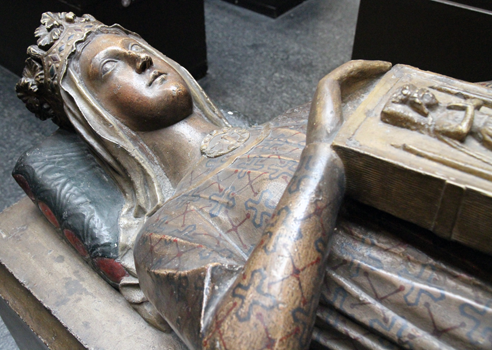 |
|
|
| Rouen Cathedral, Rouen, Seine-Maritime,
Normandy This is an active cathedral and open to the public |
 Richard I - Heart Burial |
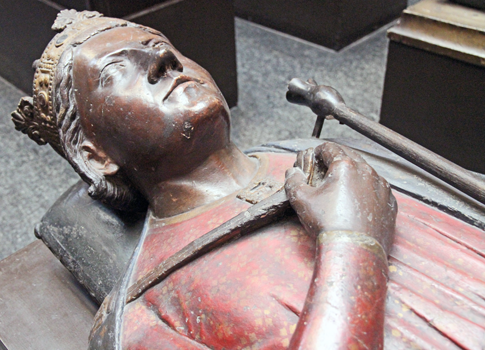 |
|
|
Spain |
| Originally in the Church of St Pedro Ocaña, near Toledo |
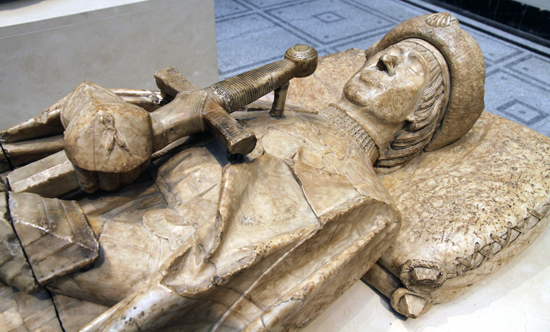 |
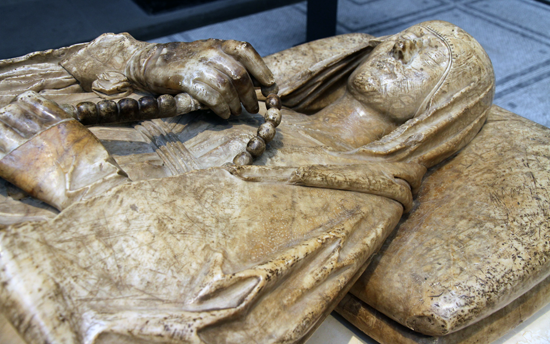 |
 |
 |
| Don Garcia de Osono (1502) and his wife, Doña Maria de Perea (1499) |
These effigies were removed from the church listed above, when it was declared unsafe in 1906. They are of alabaster and constructed 1799-1505. |
Germany |
| Römhild (near Rotermund), Hildburghausen, Thuringia, Germany |
 |
 |
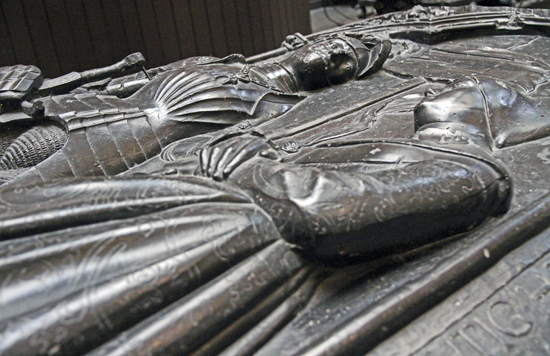 |
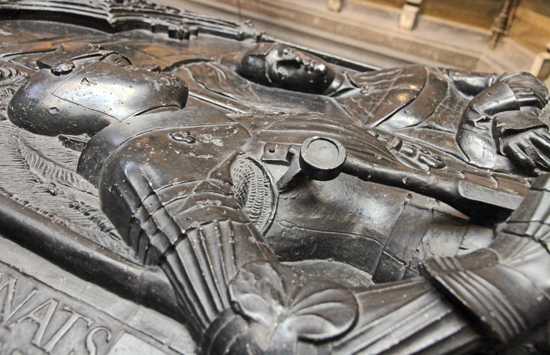 |
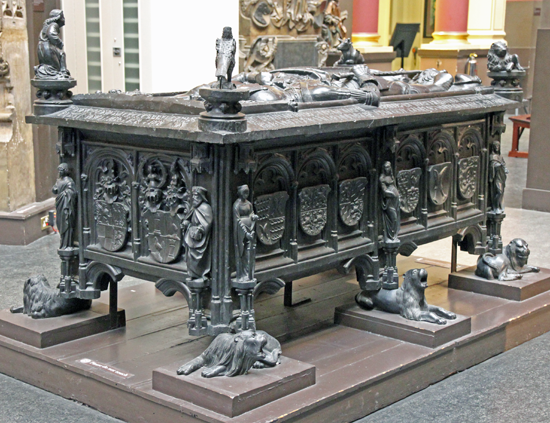 |
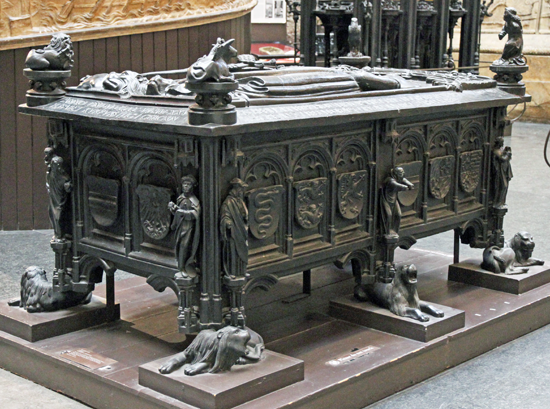 |
| Elisabeth von Hehenzollen & Herman VIII Graf von Henneberg | |
| This is painted plaster cast made in 1873 by Jacob Rotermund. The original is cast bronze by Peter Vischer the Elder based on a drawing by Albrech Dürer. Room 46A | |
| Church of St Sebaldus, Nuremberg, Bavaria, Germany |
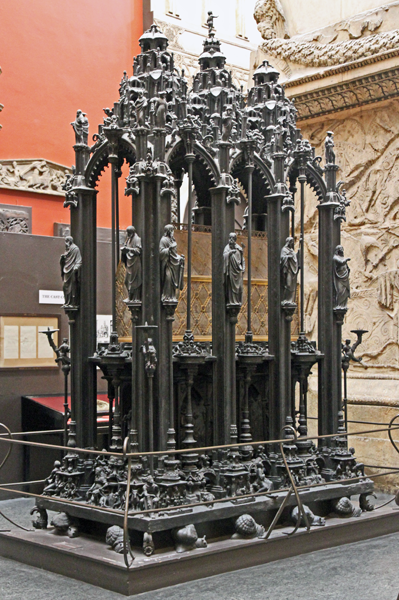 |
| St Sebaldus, the Patron Saint of Nuremberg |
| The original was
designed to hold a silver reliquary housing the remains of St
Sebaldus, and cast in bronze by
Peter Vischer the Elder in 150-19. The plaster cast was
made by Jacob Rotermunt in 1869. Room 46A |
| Magdeburg Cathedral, Magdeburg, Saxony-Anhalt, Germany |
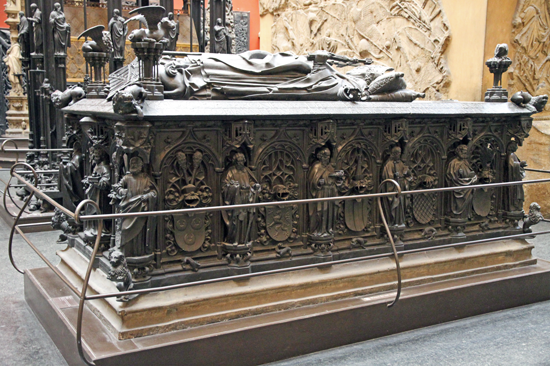 |
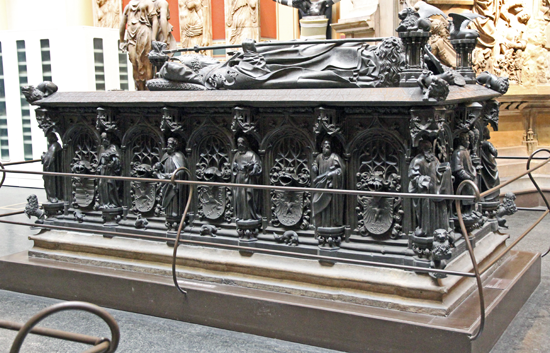 |
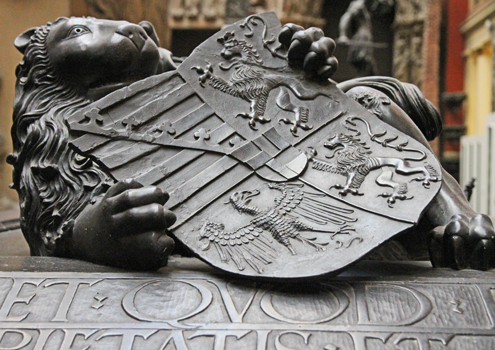 |
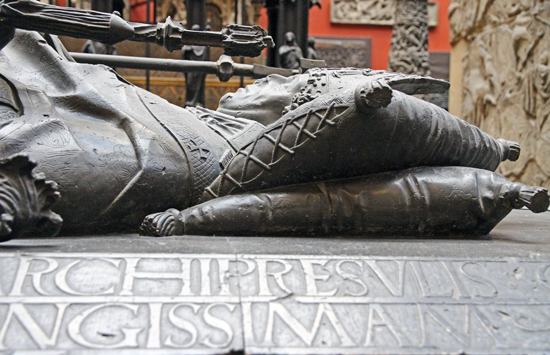 |
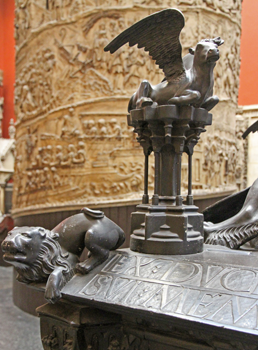 |
| Ernst, Duke of Saxony and Archbishop of Magdeburg | ||
| The original was cast in bronze at Magdebury by Peter Vischer 1497. The plaster cast was made in Berlin in 1904. Room 46A | ||
| Italy |
| Church of San Francesco, Bologna |
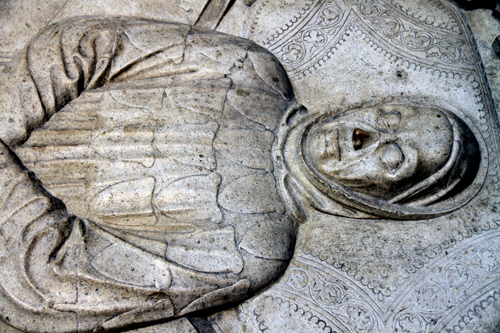 |
 |
| Tomb of a lector at
Bologna University. Identity not known. Made of Istrian stone
1425-1450. The condition suggests it was set in the wall rather than in the floor. Room 50a |
| Either from Church of Maddalena, St Cosma or St Giacomo, Venice |
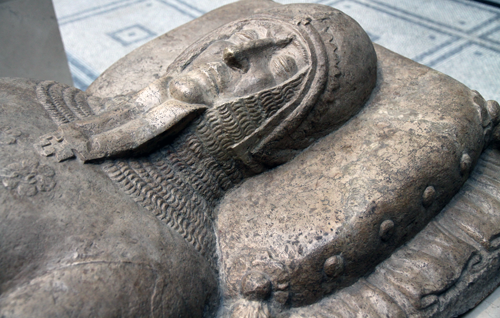 |
 |
|
| This effigy, of an unknown knight, was removed from one of the churches above, probably at the time of their suppression in the late eighteenth century and then found its way into an English private collection before being donated to the V & A. It represents an unknown knight and was carved 1370-75 in Istrian stone. Effigies of this type, period and place were wall mounted on a sarcophagus and tilted towards the observer so the could been seen. Room 50a |
| Unknown Origin - Naples | |
 |
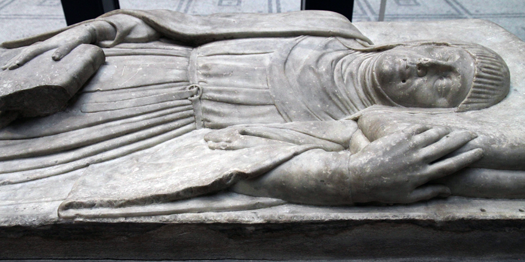 |
| Marble effigy made 1500-1550 in Naples of a lady dressing in the garments of a religious order. It was purchased by an unknown mason in that city in 1860. Room 50A | |
|
Verona |
|
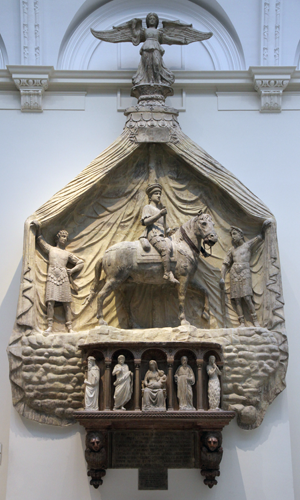 |
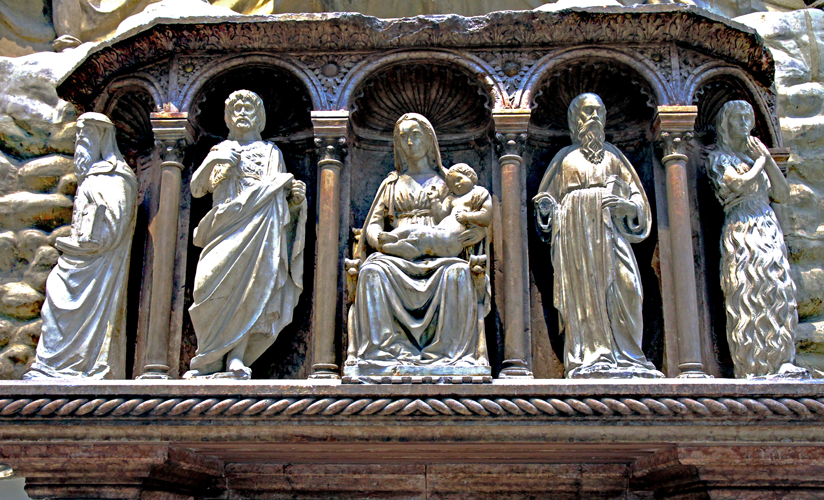 |
Marchese Spinette Malaspina (1404) |
|
| The monument - actually a
cenotaph - is constructed of stucco, marble and, Isterian stone
by Antonio da Firenze, Pietro di Lamberti, and, Giovanni de Martino; the five small terra cotta figures
of saints were heavily
restored with plaster. It was erected in the church of San
Giovanni in Saco, just outside Verona, by his heirs as
indicated on the inscription; This church was founded by
Spinetta Malaspina in 1352; he was a
condottiere or
military commander. This church was destroyed during the War of
Canbrai in 1516 and demolished the following year. A new church
was rebuilt inside the walls of Verona. The monument - either
following what must have been extensive repairs or a copy of the
original monument was transferred to the new church, as
described on an inscription below the monument, in 1536 The monument was bought by J P Richter on behalf of the museum when the then deconsecrated church which housed it had been turned into a foundry. The purchase and transportation from Italy to England did not go smoothly; these unfortunate adventures my be read on the V & A website. Room 50a. The descendents, of the founder who had the rights over the actual church as well as the monument sold both to a third party, who, intern old the monument to Mr Richter. The five statues in niches were not part of the original purchase and were sold separately. |
|
| Church of Santa Maria della Misericordia, Venice |
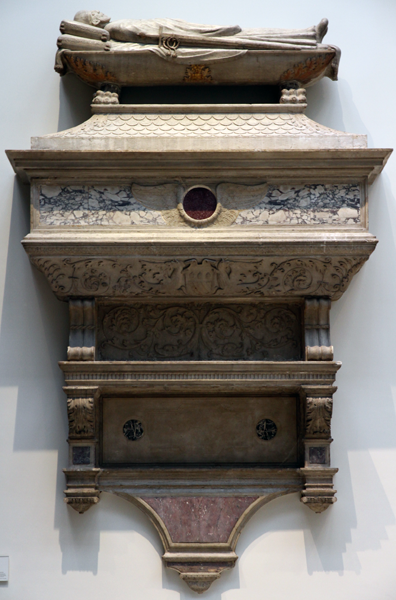 |
| This monument was bought for the then deconscerated Venitian church named above in 1881. It is thought to be a menber of the Moro family from the arms on the shield and the fact that this family was patrons of the church. No definite identification can really be made. It is of marble with in lays in the sarcopagus itself and was wall mounted. Room 50A |
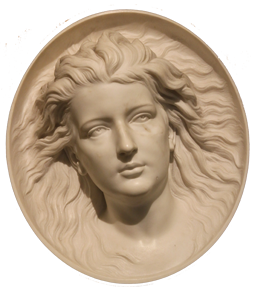 |
| These are by no means photographs of all the church monuments or casts thereof held by the V & A: some are in storage, one gallery was closed, and I may well have missed one or two! |
Please note: there were a number of effigies sent to me by Amanda Miller on the original sites; unfortunately they were then - by necessity of a reduced size. I cannot find the original files - except for very few, which I will edit and add shortly. I do not want the old reduced images to not be used - so I will have to add these reduced images where I can find no others.
<City of London I > <City of London II> <City of London III> <City of Westminster-1> <City of Westminster-2> <City of Westminster-3> <City of Westminster-4> <Borough of Wandsworth>
